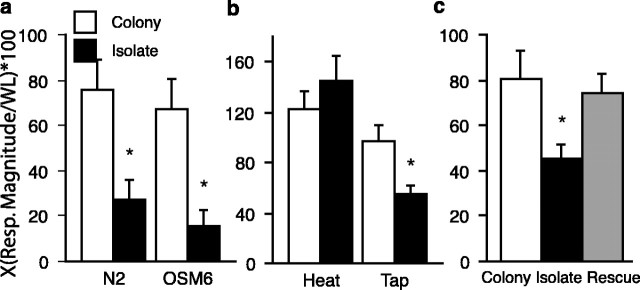Figure 1.
Effects of isolation on tap withdrawal response. a, Mean tap response magnitude (Resp. Magnitude) for wild-type (N2) worms and a chemosensory mutant (osm-6). The isolate-raised worms of both strains showed significantly smaller responses to tap than did the colony-raised worms (n = 20 per group). b, Effects of isolation on reversals to heat. Mean reversal magnitude to tap and to heat probe for isolate-raised and colony-raised worms (n = 20 per group). Isolate-raised worms had significantly smaller responses to tap than colony worms. There were no differences between the isolate-raised and colony-raised worms' responses to the heat probe. c, Effects of stimulation on isolated worms. Mean tap response magnitude for colony-raised, isolate-raised, L3 stimulated colony-raised worms, and L3 stimulated isolate-raised worms (L3 worms were raised in colony or isolation but were given brief stimulation during the third larval stage). Brief mechanosensory stimulation in L3 reversed the effects of isolation on behavior. Stimulated isolate-raised responses to tap were larger than the isolate-raised worms and not different from colony-raised or stimulated-colony raised worms. The asterisks represent statistically significant pairs. Error bars represent SEM. WL, Worm length.

